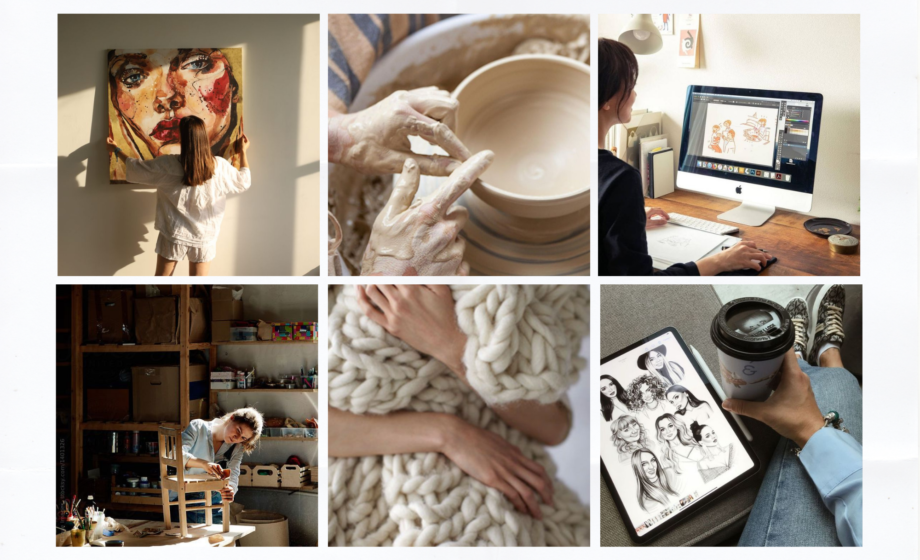In today’s fast-paced world, finding time for creative hobbies can greatly enhance your well-being and spark joy in your life. Exploring new creative outlets can lead to personal growth, improved mental health, and a richer emotional experience.
Whether you have a few free hours each week or are looking to fill your spare time, engaging in creative activities allows you to express yourself and connect with your interests. This article will highlight five creative hobbies that can inspire you to nurture your artistic side.



1) Painting Landscapes
Painting landscapes allows you to capture the beauty of nature in a personal way. You can choose to work from photographs, real-life scenes, or even your imagination.
This hobby enhances your observation skills and encourages you to explore different environments. You might find inspiration in mountains, forests, or coastal views.
Focusing on landscapes offers various techniques to learn. You can experiment with colors, shadows, and brushwork to convey depth and form.
Using different mediums like watercolors, acrylics, or oils invites creative exploration. Each medium provides unique opportunities to express your vision.
As you progress, consider participating in local art groups or online communities. Sharing your work and receiving feedback can be invaluable for your growth.



2) Knitting Sweaters
Knitting sweaters is a rewarding and practical hobby. With each stitch, you create a unique piece of clothing that can keep you warm and express your personal style.
You start by selecting yarn and a pattern that suits your skill level. Many beginners choose simple patterns to build confidence before tackling more complex designs.
Understanding basic knitting techniques, like casting on and the various stitches, is essential. As you practice, you can explore different textures and colors.
Knitting not only enhances your creativity but also offers a sense of accomplishment. Wearing something you made with your own hands adds personal value to your wardrobe.
Joining knitting groups or online communities can provide support, inspiration, and new techniques. Sharing your progress with others can enrich the experience.
Knitting sweaters can also be a thoughtful gift for friends and family. Handmade items often carry sentimental value that store-bought alternatives can’t replicate.



3) Digital Illustration
Digital illustration allows you to create art using software and digital tools. This medium combines traditional techniques with modern technology, making it accessible for anyone with a passion for art.
You can choose from various programs, such as Adobe Illustrator, CorelDRAW, or free options like Krita and Inkscape. Each offers unique features that cater to different styles and preferences.
Working in digital formats provides flexibility. You can easily undo mistakes, experiment with colors, and manipulate layers without damaging your original work.
You might explore different styles, from cartooning to realistic portrayals. This variety keeps the creative process engaging and allows you to develop your voice as an artist.
Sharing your artwork is straightforward. Platforms like Instagram and Behance enable you to showcase your work and connect with other artists.
Digital illustration also opens up opportunities for freelance work, including illustration for books, marketing materials, and web content. This pursuit can turn a hobby into a potential source of income while honing your skills.


4) Woodworking
Woodworking is a creative hobby that allows you to craft furniture, décor, and more from wood. Whether you’re a beginner or have some experience, it can be both satisfying and productive.
You can start by finding simple projects like birdhouses or small shelves. These projects help you learn essential skills such as measuring, cutting, and joining wood.
As you gain confidence, you can progress to more complex creations. Consider building a table or a custom storage solution for your home. The possibilities are endless.
Investing in the right tools is crucial. Basic tools include a saw, hammer, and measuring tape. As you advance, you might explore power tools for efficiency.
Woodworking also encourages problem-solving and creativity. Each project presents unique challenges, pushing you to find solutions and refine your techniques. You can personalize your projects, making them truly yours.
Working with wood can be therapeutic. The focus required helps clear your mind, providing a rewarding escape from daily routines. Consider woodworking as a hobby to express your creativity and enhance your skills.


5) Pottery Wheel
Using a pottery wheel can be a fulfilling creative hobby. It combines tactile engagement with artistic expression. The process allows you to shape clay into functional or decorative pieces.
You begin with a lump of clay, centering it on the wheel. As the wheel spins, you use your hands to mold the clay into forms like bowls or vases. This hands-on experience is satisfying and meditative.
Working with a pottery wheel also introduces you to various techniques. You can experiment with glazing, texturing, and firing your creations. Each piece is unique, reflecting your style and skill level.
Joining a pottery class can enhance your experience. You’ll learn from instructors and connect with others who share your interest. The community aspect can motivate and inspire you to improve.
Whether you’re a beginner or more advanced, pottery can be an enjoyable way to unwind and express creativity. You may find that each session brings new challenges and rewards.


Benefits of Creative Hobbies
Engaging in creative hobbies can enhance your life significantly. They not only contribute to your mental well-being but also foster social connections.
Mental Health Benefits
Creative hobbies serve as an effective outlet for expressing feelings and thoughts. Activities like painting, writing, or crafting can help reduce stress by allowing you to focus your mind on enjoyable tasks.
- According to studies, creative expression lowers anxiety levels.
- It can also combat symptoms of depression by promoting positive emotions.
Involving yourself in creative pursuits boosts your self-esteem. Completing a project offers a sense of accomplishment. You can also experience flow, a state where you are fully immersed in the activity, which promotes happiness and satisfaction.
Social Interaction
Participating in creative hobbies often leads to opportunities for social engagement. Join classes, workshops, or community groups to connect with like-minded individuals.
- Forming relationships through shared interests can enhance your social life.
Collaborative projects, such as group art exhibits or community theater, promote teamwork and communication skills. These interactions can provide invaluable social support.
Meeting people in a relaxed, creative environment helps to build friendships based on mutual interests, further enriching your life.


Getting Started with Creative Hobbies
Embarking on a creative hobby can be both fulfilling and enjoyable. To get started, it’s essential to choose a hobby that resonates with you and gather the necessary supplies.
Choosing the Right Hobby
Selecting a creative hobby involves considering your interests and the time you can dedicate. Think about what activities excite you, whether it’s painting, writing, knitting, or photography.
Here are some questions to help narrow your choices:
- What do you enjoy? Identify activities that spark joy or curiosity.
- What skills do you wish to develop? Consider hobbies that enhance your existing skills.
- How much time can you invest? Choose a hobby that fits into your schedule.
You might test a few hobbies before settling on one that truly resonates.
Gathering Supplies
Once you have chosen a hobby, you’ll need the right materials to get started. Make a list of essential supplies based on your hobby choice.
For example, if you select painting, consider:
- Paints (acrylic, watercolor, or oil)
- Brushes in various sizes
- Canvas or paper suitable for your medium
For hobbies like knitting, essential items include:
- Yarn in your preferred colors
- Knitting needles of appropriate size
- Patterns to guide your projects
Research the basic supplies necessary for your hobby, and consider visiting local craft stores or online shops. Ensuring you have the right tools will help you enjoy your creative journey.


Maintaining Motivation
Staying motivated in a creative hobby requires intentional effort and strategies. By setting achievable goals and regularly tracking your progress, you can cultivate a sense of accomplishment that keeps you engaged.
Setting Achievable Goals
Define specific, realistic goals that can guide your creativity. Break larger projects into smaller, manageable tasks. For example, if your goal is to complete a painting, set milestones like sketching, selecting colors, and finishing the background.
Utilize the SMART criteria for your goals:
- Specific: Clearly outline what you want to achieve.
- Measurable: Establish criteria to evaluate your progress.
- Achievable: Ensure that your goals are within reach.
- Relevant: Align your goals with your interests.
- Time-bound: Set deadlines to maintain focus.
This method helps to prevent overwhelm and fosters a feeling of accomplishment as you complete each step.
Tracking Progress
Monitoring your progress can significantly enhance your motivation. Keep a journal or use apps to document your journey. Write down what you’re working on, your feelings about the process, and any challenges you face.
Consider maintaining a visual progress board. Include:
- Photos of completed tasks
- Checklists for upcoming milestones
- Inspirational quotes
Review your progress regularly. This can boost your motivation by highlighting achievements and encouraging you to push through obstacles. Tracking also allows you to adjust your goals if needed, keeping your engagement high and frustration low.






